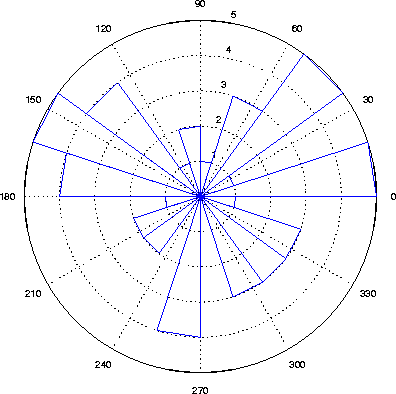Angle histogram
Syntax
rose(theta)
rose(theta,x)
rose(theta,nbins)
[tout,rout] = rose(...)
Description
rose
creates an angle histogram, which is a polar plot showing the distribution of values grouped according to their numeric range. Each group is shown as one bin.
rose(theta)
plots an angle histogram showing the distribution of theta in 20 angle bins or less. The vector theta, expressed in radians, determines the angle from the origin of each bin. The length of each bin reflects the number of elements in theta that fall within a group, which ranges from 0 to the greatest number of elements deposited in any one bin.
rose(theta,x)
uses the vector x to specify the number and the locations of bins. length(x) is the number of bins and the values of x specify the center angle of each bin. For example, if x is a five-element vector, rose distributes the elements of theta in five bins centered at the specified x values.
rose(theta,nbins)
plots nbins equally spaced bins in the range [0, 2*pi]. The default is 20.
[tout,rout] = rose(...)
returns the vectors tout and rout so polar(tout,rout) generates the histogram for the data. This syntax does not generate a plot.
Example
Create a rose plot showing the distribution of 50 random numbers:
theta = 2*pi*rand(1,50);
rose(theta)

See Also
compass, feather, hist, polar
[ Previous | Help Desk | Next ]
